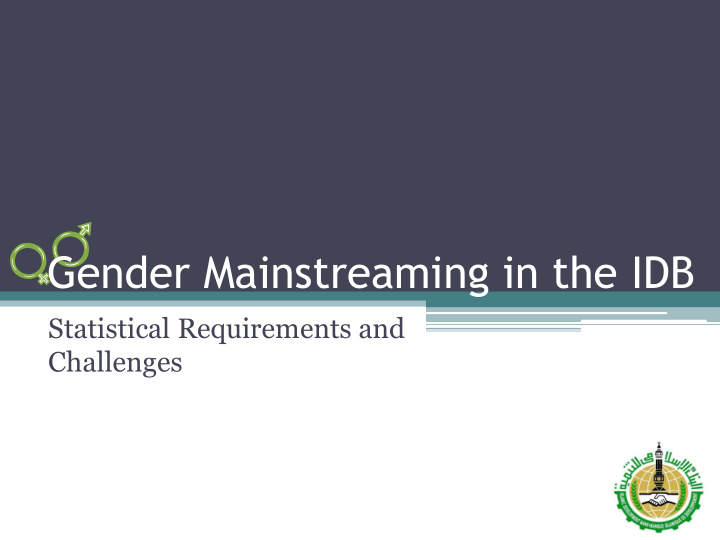



Gender Mainstreaming in the IDB Statistical Requirements and Challenges
Table of Contents • Brief on the IDB • Gender Mainstreaming in the IDB • Gender Analysis and Statistical Needs • Conclusions
General Overview • Established in 1975 • Multilateral Financial Institution • Only South-South Membership • Islamic Modes of Financing • Areas of Focus: ~ Comprehensive Human ~ Private Sector Development Development & Poverty Reduction ~ Capacity Development ~ Infrastructure ~ Economic Cooperation ~ Islamic Finance
Milestones for Gender Mainstreaming in the IDB • 1440 Vision Women in • Women’s Observer Development IDB Women’s Mainstreaming Unit Advisory Panel MDB-WGG Strategy 1998 2002 2004 2006 2007 2009 2011 2012 2013 • 13 th Annual IDB Prize for Women’s Gender CoP Symposiusm Women’s Empowerment • Gender-NGO “Women in Contribution Mainstreamed Divsion Poverty to in all Functions Alleviation: Development of the IDB Better Access to Education and Microfinance
IDB Focus Areas of Gender Mainstreaming • Set Policies and Strategies • Country Dialogue • Ensure Gender Dimension in each Operations as Appropriate from Identification, Implementation and Evaluation
How can we Mainstream? • Gender Analysis • Gender Assessments • Allocation of Resources • Cooperation and Collaboration • Research and Information Dissemination on Gender Issues
New Directions • Scaling up from Sex-disaggregated Data to Gender Analysis • Increase Support to MCs • Increase Resource Allocation
Why we need Gender Statistics and Analysis To get a full picture of the whole population to identify gender issues and provide effective assistance • Gives a general picture of the roles, situations, and conditions of women and men • It helps to identify disparities/biases • Ensure women beneficiaries changing disparities
Indicative areas for Gender Statistics in IDB Priorities Women’s access to and utilization of infrastructure Comprehensive Islamic Finance Gender-specific Women’s access to Infrastructure Development Development routes to poverty banking and financial services Human Enabling environment Capacity Development for women Women’s role in Private Sector Development productive activities and access to resources Women’s role in intra -IDB trade and other economic Economic Cooperation cooperation activities
Shortcomings of Current Gender Statistics • Poorly Available Data • Inadequate Gender Assessment/analysis • Cultural Sensitivities
Some Available Statistical Information on Gender • UNSD ’s Statistics and Indicators on Women and Men • UNDP ’s Gender -related Development Index (GDI) and Gender Empowerment Measure (GEM) • World Bank ’s GenderStats Database • DEVINFO ’s GenderInfo • OECD ’s Gender , Institutions and Development Database (GID-DB) and Social Institutions and Gender Index (SIGI) • WIDNET ’s Women in Development Statistics ( WIDStats)
Potential Challenges • No strategic framework for gender statistics at OIC level • Sensitivities, social norms, and cultural backgrounds • Poor statistical infrastructure in some MC • Gender not fully mainstreamed into primary data collection tools • Little dialogue between producers and users
Recommendations • Develop a framework for gender statistics at OIC level • Review concepts and definitions • Mainstream gender in NSOs’ activities • Establish an OIC Gender Statistics Database • Conduct qualitative studies • Leverage resources and partnership
Proposed Way forward • OIC Gender Index ▫ Recommendation of IDB Women Advisory Panel to create a composite gender index to reflect social and economic environment in OIC Member Countries • Regular OIC Gender Report ▫ Provide an analysis on the situation of women in OIC MCs taking into account the context of social and cultural norms
Recommend
More recommend